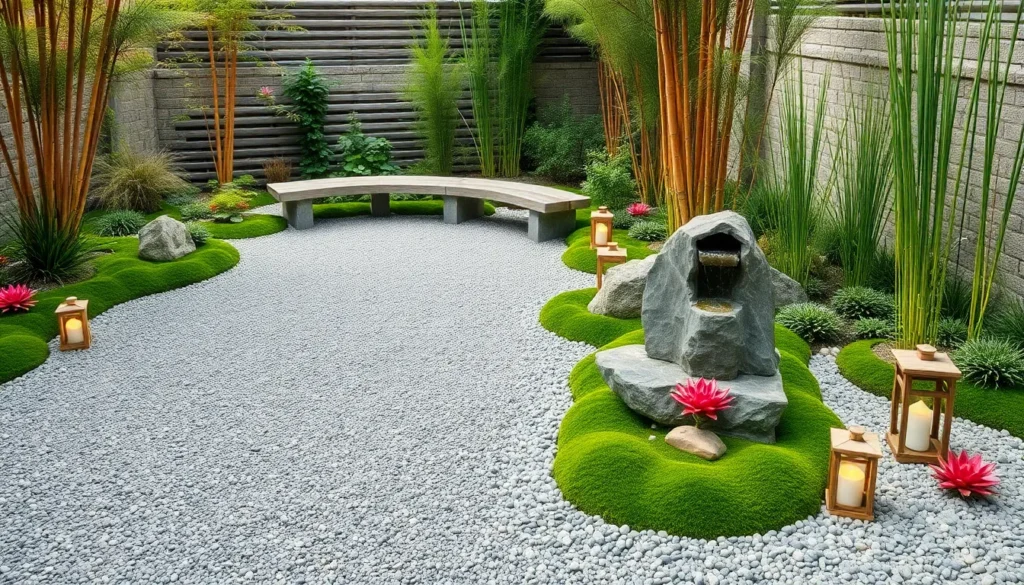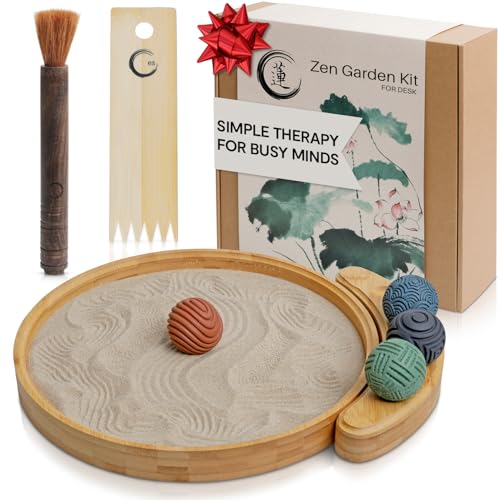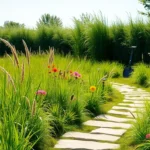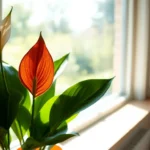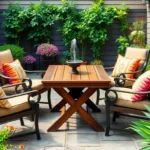Creating a zen garden transforms any outdoor space into a peaceful sanctuary where we can escape life’s daily chaos. These minimalist landscapes aren’t just beautiful—they’re powerful tools for meditation and stress relief that bring ancient Japanese wisdom right to our backyards.
We’ve discovered that designing the perfect zen garden doesn’t require years of training or massive budgets. Whether you’re working with a small balcony or expansive yard, the right combination of rocks, sand, plants, and water features can create that coveted sense of tranquility we all crave.
The beauty of zen gardens lies in their simplicity and the profound calm they generate. From traditional raked gravel patterns to modern interpretations featuring succulents and bamboo, we’ll explore creative ideas that’ll help you create a meditative space that speaks to your soul and enhances your daily well-being.
Create a Traditional Raked Sand Garden
Traditional raked sand gardens capture the essence of Japanese zen philosophy through simple yet profound design elements. These meditative spaces transform ordinary outdoor areas into peaceful sanctuaries that promote mindfulness and inner calm.
Choose the Right Sand Type and Texture
Fine decomposed granite works exceptionally well for traditional zen gardens because it holds patterns longer than regular sand. We recommend using particles that measure between 1-3mm in diameter for optimal raking consistency and visual appeal.
White sand creates the most authentic appearance and reflects light beautifully throughout different times of day. Crushed marble or white quartz sand provides excellent alternatives when traditional Japanese sand isn’t available in your area.
River sand offers a natural gray color that many gardeners prefer over bright white varieties. This type typically contains fewer impurities and compacts well without becoming too hard for raking maintenance.
Avoid playground sand since it’s too coarse and won’t hold delicate patterns effectively. Beach sand also presents challenges because salt content can damage surrounding plants and garden elements.
Select Appropriate Raking Tools and Patterns
Wooden rakes with wide tines create broad, flowing patterns that mimic ocean waves and natural water movements. We suggest using rakes with 6-8 tines spaced approximately 2 inches apart for traditional wave patterns.
Mini hand rakes allow for precise detail work around rocks, plants, and garden borders. These smaller tools typically measure 6-12 inches in width and work perfectly for maintaining tight spaces and intricate designs.
Straight line patterns represent calm water and peaceful states of mind in traditional zen philosophy. Create these by pulling your rake in long, steady strokes across the entire sand surface without interruption.
Curved patterns suggest flowing water and natural movement throughout your garden space. Start with gentle S-curves before attempting more complex spiral or circular designs that require steady hand control.
Design Meaningful Wave and Circle Motifs
Concentric circles around large stones symbolize ripples spreading outward from dropped pebbles in still water. Begin at the stone’s edge and work outward in gradually expanding circles to achieve this classic zen garden motif.
Wave patterns flowing around obstacles create ever-changing visual interest while representing water’s natural ability to adapt and flow. Use consistent spacing between wave crests to maintain harmony and balance throughout your design.
Intersecting patterns where different motifs meet should blend seamlessly rather than clash or compete for attention. Practice transitioning from waves to circles using gentle curves that connect the different pattern types naturally.
Seasonal adjustments to your patterns keep the garden fresh and reflect changing natural cycles throughout the year. Consider creating more turbulent wave patterns during autumn months and smoother designs during peaceful spring seasons.
Incorporate Natural Stone Elements
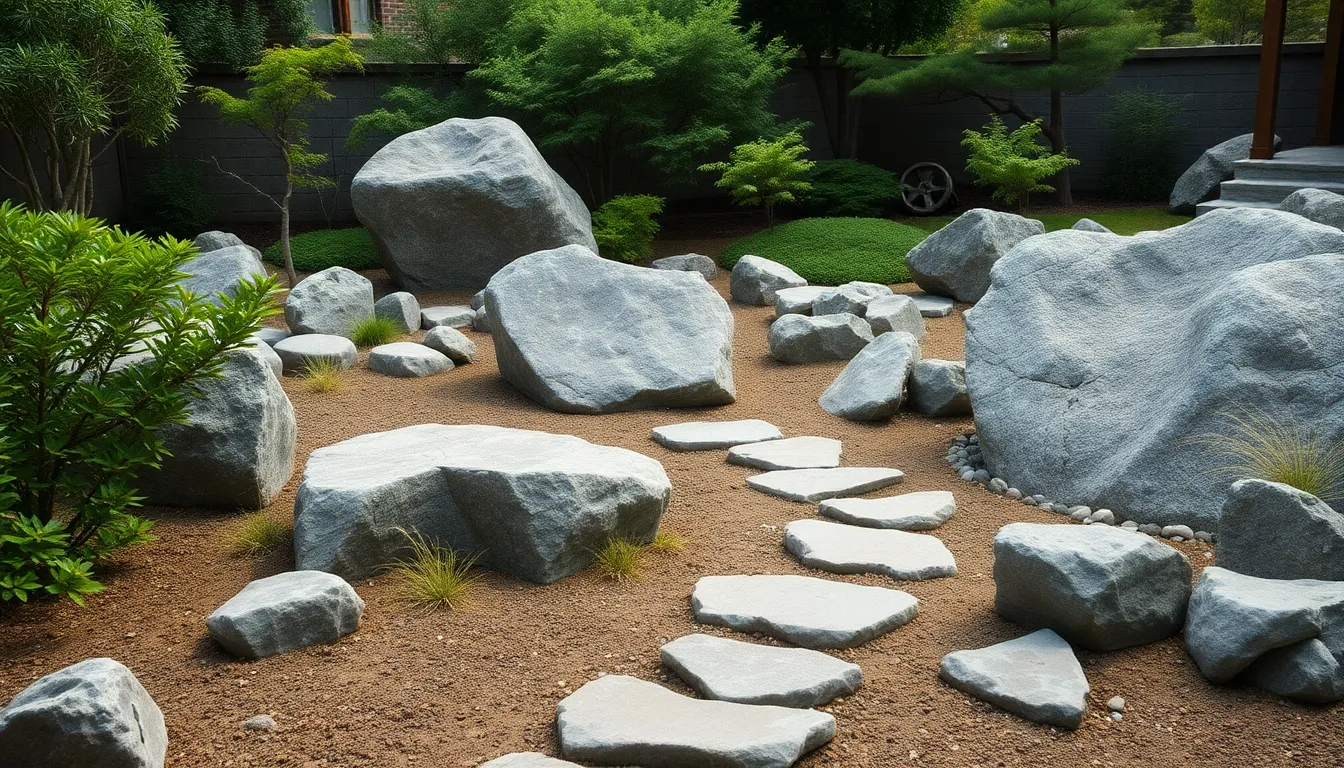
Stone elements serve as the backbone of any zen garden, providing structure and visual interest that creates lasting tranquility. We’ll explore how different types of stones can transform your peaceful sanctuary into a meditation haven.
Position Large Anchor Rocks as Focal Points
Large anchor rocks create the primary visual foundation of your zen garden design. We position these substantial stones strategically to represent mountains or islands, drawing the viewer’s attention and encouraging deep contemplation. Placement matters significantly – larger rocks typically symbolize stability and permanence, while their positioning establishes the garden’s overall energy flow.
Balance becomes essential when working with anchor rocks, as we pair them with smaller elements like gravel or sand to maintain visual equilibrium. Create focal points by placing your largest stone slightly off-center, following the rule of thirds that naturally guides the eye. Consider the viewing angles from different positions in your garden to ensure the anchor rock commands attention from multiple perspectives.
Arrange Smaller Stones for Balance and Harmony
Smaller stones provide the supporting framework that maintains cohesion throughout your zen garden space. We use these elements to create pathways, borders, and decorative patterns that complement rather than compete with the larger anchor rocks. Harmony emerges when smaller stones are arranged with intentional spacing and thoughtful placement.
Pathways formed by smaller stones guide visitors through your garden while inviting reflection and mindfulness. Create winding paths that encourage slow, contemplative movement rather than direct routes. Group stones in odd numbers like three or five to maintain visual interest and follow natural design principles that feel organic rather than forced.
Use River Rocks for Textural Contrast
River rocks introduce smooth, polished surfaces that create striking textural contrast against rougher stone elements. We incorporate these naturally weathered stones to add visual and tactile interest that enhances the overall sensory experience. Smooth surfaces provide a calming counterpoint to the angular edges of larger rocks, creating balance through diversity.
Visual patterns emerge when we use river rocks to line water features or create decorative arrangements throughout the garden. Place them around the base of larger stones to soften transitions and create natural-looking compositions. Consider using river rocks of varying sizes and colors to add depth while maintaining the serene, monochromatic palette that defines zen garden aesthetics.
Add Carefully Selected Plants and Greenery
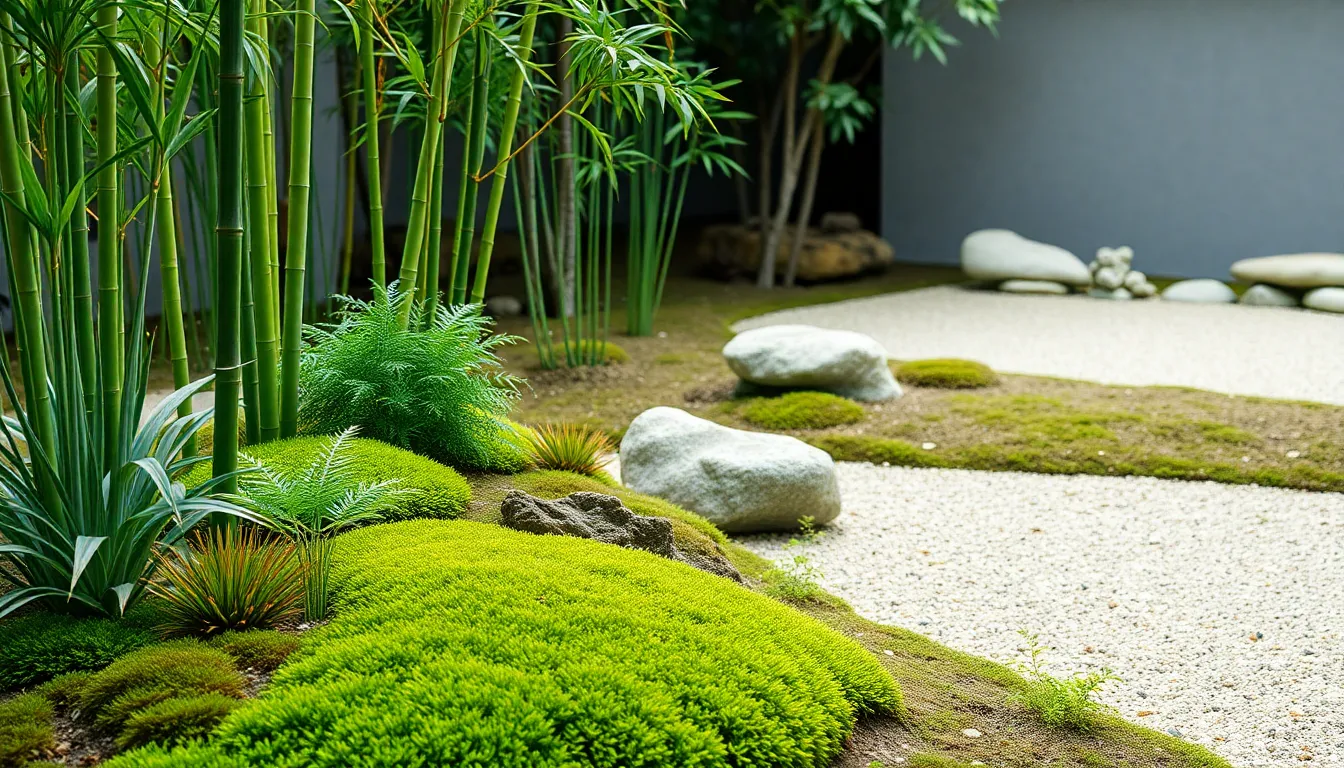
While stones and sand create zen garden foundations, carefully selected plants bring life and natural balance to these peaceful spaces. We recommend choosing plants that align with zen principles of simplicity and require minimal maintenance to preserve the garden’s tranquil atmosphere.
Choose Low-Maintenance Moss Varieties
Mosses provide the perfect foundation for zen garden plantings due to their minimal care requirements and natural ability to thrive in shaded, moist environments. We find these plants particularly valuable because they create lush, serene backdrops without demanding constant attention. Different moss varieties offer unique colors and growth patterns, allowing us to customize the garden’s appearance based on our preferences.
Sedum varieties work exceptionally well alongside traditional mosses, offering low-maintenance succulent options in various colors and textures that complement small zen spaces perfectly. These plants require virtually no watering once established and provide year-round visual interest through their diverse forms.
Ferns pair beautifully with moss plantings to establish naturally layered environments that feel both ancient and peaceful. We recommend selecting native fern species that naturally occur in woodland settings, as they’ll integrate seamlessly with moss groundcover while requiring minimal intervention.
Include Bamboo for Vertical Interest
Bamboo transforms zen gardens by adding essential vertical elements that create natural privacy screens and architectural interest. We appreciate how bamboo’s gentle rustling sounds enhance the garden’s auditory experience while providing living walls that define spaces naturally. But, containing invasive bamboo varieties becomes crucial to prevent unwanted spreading throughout the garden area.
Japanese Sedge and Japanese Boxwood offer alternative vertical elements that add structure without bamboo’s aggressive growth patterns. These plants provide textural contrast against softer moss and fern plantings while maintaining the clean lines essential to zen design principles.
Grouping bamboo strategically creates focal points that draw the eye upward without overwhelming the space’s peaceful proportions. We suggest using bamboo as backdrop elements rather than central features to maintain visual balance throughout the garden design.
Plant Ornamental Grasses for Gentle Movement
Ornamental grasses introduce natural movement that enhances zen gardens’ meditative qualities through their gentle swaying motions. We select grasses based on their height variations and textural qualities, ensuring they complement rather than compete with other garden elements. These plants require minimal maintenance once established and provide seasonal interest through changing colors and seed heads.
Bonsai trees serve as exceptional companions to ornamental grasses, symbolizing harmony and balance while creating stunning focal points or grouped displays. We position these carefully cultivated trees to anchor grass plantings and provide structural elements that ground the garden’s overall composition.
Creating gentle transitions between different plant heights and textures helps establish natural flow patterns that guide visitors through contemplative experiences. We arrange plantings to frame views of raked sand patterns and stone arrangements, ensuring each element supports the garden’s unified peaceful atmosphere.
Install Water Features for Tranquil Sounds
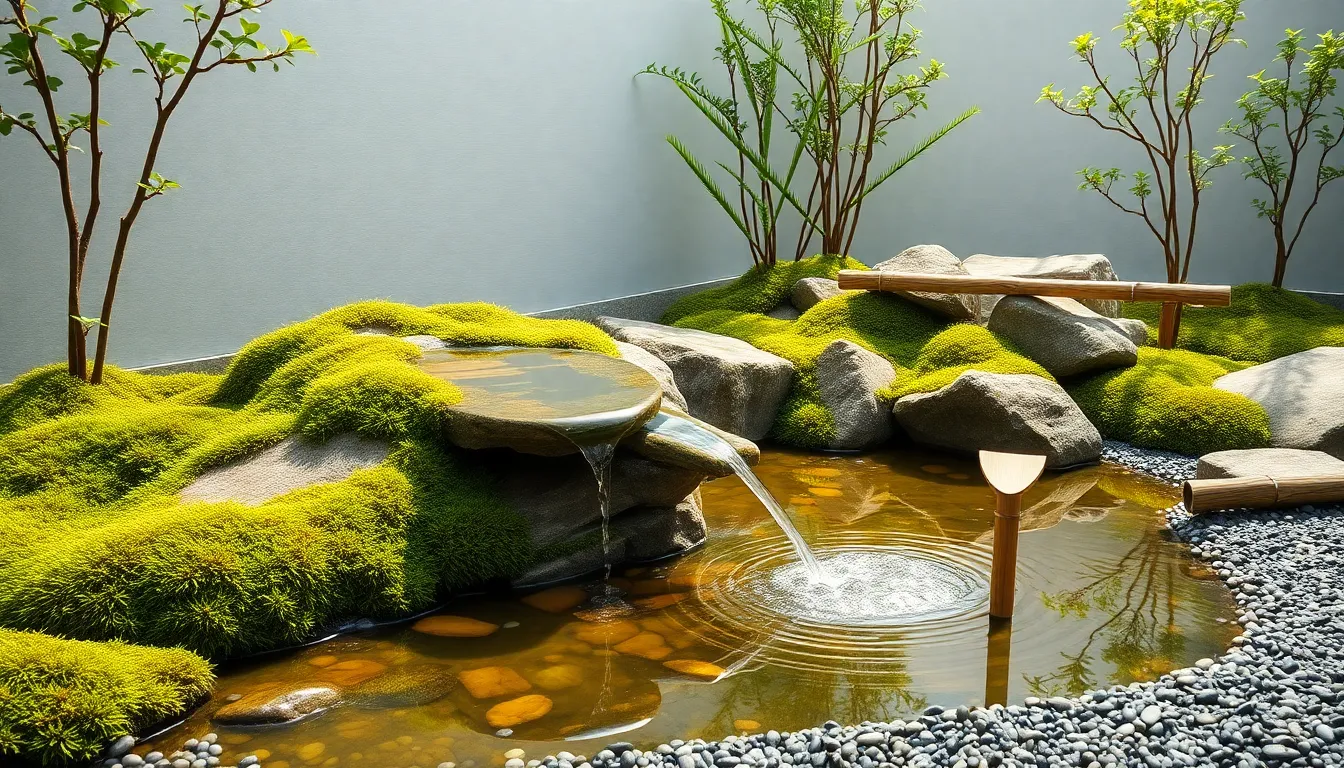
Water features bring the element of sound to our zen garden while creating focal points that enhance meditation and relaxation. The gentle flow of water naturally masks ambient noise and provides the soothing sounds that make zen gardens so groundbreaking.
Design a Simple Stone Fountain
Creating a stone fountain starts with selecting natural materials like limestone or granite that complement our garden’s existing stone elements. We position the fountain stones strategically to create a gentle water flow that produces minimal splashing sounds. Natural stone fountains blend seamlessly with the zen aesthetic while requiring only a small pump to circulate water continuously.
Moss and small plants around the fountain base enhance the natural ambiance we’ve already established with our other plantings. The stone structure should maintain clean lines inspired by Asian design principles, avoiding ornate details that might distract from the garden’s peaceful atmosphere. We ensure the fountain’s height and proportions create visual harmony with our existing anchor rocks and pathways.
Create a Shallow Reflecting Pool
Shallow reflecting pools capture the sky and surrounding industry, adding depth and visual tranquility to our zen space. We design the pool to mirror the clouds and trees above while maintaining water levels that prevent stagnation. The reflection creates an illusion of expanded space that enhances the garden’s meditative qualities.
Strategic stone placement within the pool adds visual interest without disrupting the peaceful water surface. Floating plants can provide subtle movement and natural filtration while maintaining the pool’s clarity. We position the reflecting pool where it catches natural light throughout different times of day, creating changing reflections that keep the space ever-changing.
Add a Gentle Bamboo Water Spout
Bamboo water spouts provide authentic Asian garden elements while creating distinctive trickling sounds that complement our existing water features. We create these spouts using natural bamboo materials that weather beautifully and maintain the organic feel of our zen garden. The gentle water release creates rhythmic sounds that support meditation and mindfulness practices.
Natural materials like bamboo and wood ensure the water spout integrates seamlessly with our garden’s existing elements. We position the spout to create a steady water flow that fills slowly before releasing, producing the traditional hollow bamboo sound that’s characteristic of Japanese gardens. The spout’s placement should direct water toward stones or gravel areas where the sound resonates most effectively.
Build Pathways for Mindful Walking
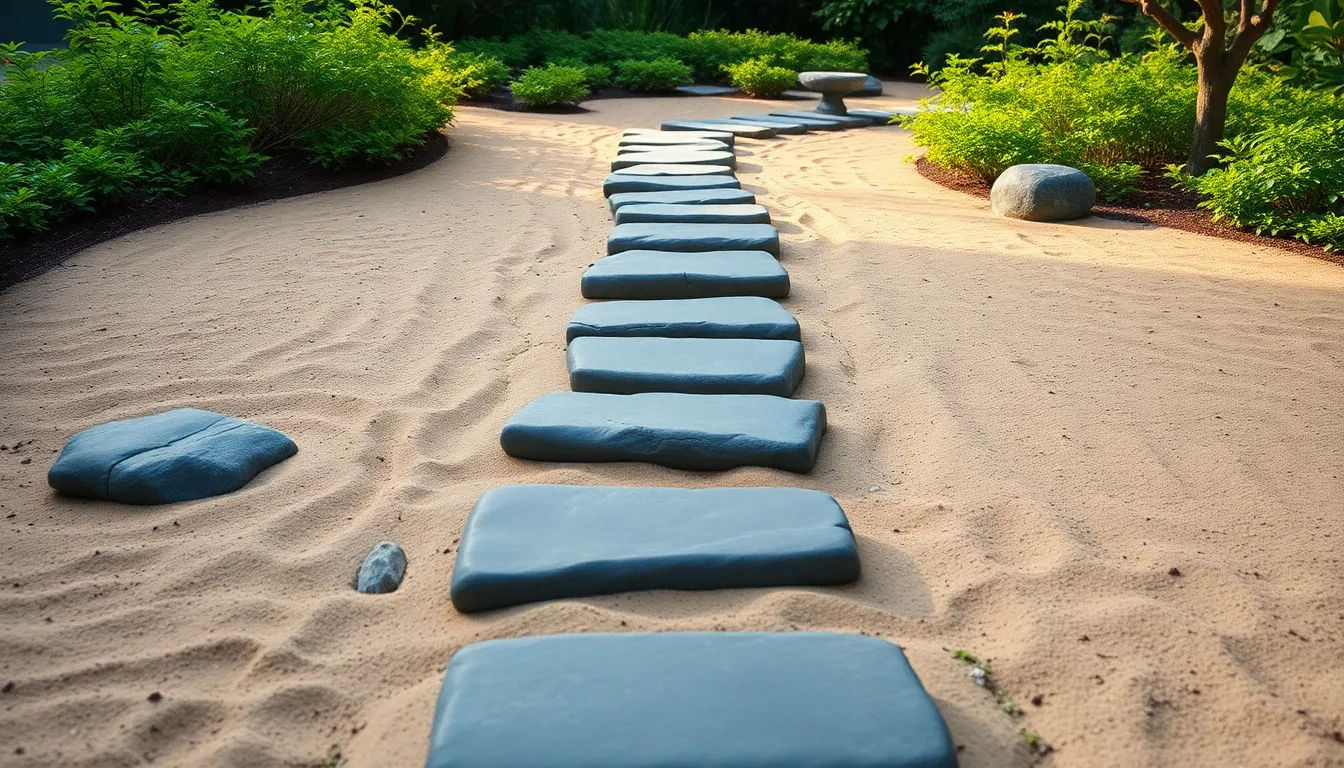
Creating intentional walkways transforms your zen garden into a space for active meditation and contemplative movement. We’ll explore three distinctive pathway approaches that encourage slow, deliberate steps and deeper connection with your peaceful sanctuary.
Construct Stepping Stone Trails
Flat stones create the foundation for mindful walking meditation in your zen garden. We recommend selecting stones that measure 12-18 inches in diameter to provide stable footing while maintaining visual harmony with your existing rock elements.
Position each stone 18-24 inches apart to encourage a natural, unhurried pace that supports contemplative movement. This spacing forces us to focus on each step rather than rushing through the garden experience.
Create gentle curves in your stepping stone arrangement to mirror the organic flow patterns found in your raked sand sections. Winding paths naturally slow our walking speed and invite us to notice different perspectives of the garden as we move through the space.
Embed stones slightly into the ground to ensure stability while maintaining the garden’s clean aesthetic lines. We suggest using a rubber mallet to level each stone and prevent wobbling that could disrupt the meditative walking experience.
Design Curved Gravel Walkways
Gravel pathways offer textural contrast to your zen garden’s smooth sand areas while providing satisfying sensory feedback underfoot. We recommend using decomposed granite or fine pea gravel that compacts well and creates subtle crunching sounds during walking meditation.
Shape curved walkways to complement your garden’s natural flow patterns and existing water features. These gentle curves encourage us to slow down and experience the garden from multiple vantage points rather than moving directly from entrance to exit.
Install industry edging along pathway borders to contain the gravel and maintain clean lines between different garden zones. Metal or stone edging materials work best as they withstand weather conditions while preserving the garden’s minimalist aesthetic.
Apply gravel in 2-3 inch depths to ensure comfortable walking while preventing weeds from emerging through the pathway surface. We find this depth provides optimal drainage during rain while maintaining the contemplative walking experience your zen garden requires.
Create Wooden Boardwalk Sections
Wooden boardwalks add natural warmth to zen gardens while elevating walkways above ground level plantings and water features. We suggest using cedar or teak materials that weather beautifully and resist moisture damage in outdoor environments.
Construct boardwalks 3-4 feet wide to accommodate comfortable walking while maintaining proportional scale with your garden’s other elements. This width allows us to walk mindfully without feeling constrained while preserving the intimate atmosphere essential to zen garden design.
Elevate boardwalk sections 6-12 inches above ground level to create visual separation between pathway and garden zones. This elevation change naturally slows our walking pace and provides opportunities to observe moss, small plants, and stone arrangements from a contemplative viewing angle.
Connect wooden sections with your stepping stone and gravel pathways to create a varied walking meditation circuit throughout the garden space. These material transitions provide tactile variety that keeps us present and engaged during our mindful movement practice.
Establish Dedicated Meditation Zones
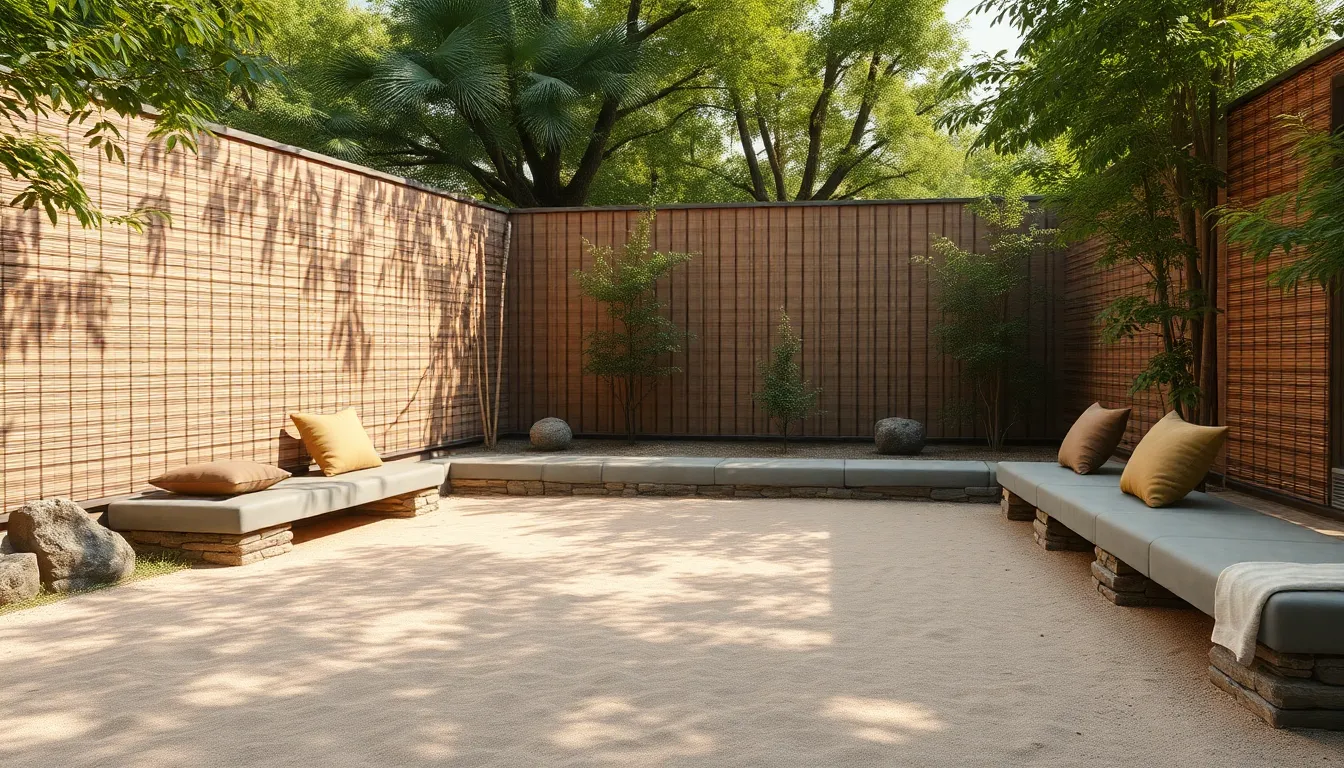
Creating exact areas for contemplation transforms your zen garden into a purposeful sanctuary for mindfulness practice. We’ll explore how to design meditation zones that encourage deep reflection and inner peace.
Position Comfortable Seating Areas
Natural stone benches offer the perfect foundation for meditation spaces that blend seamlessly with your zen garden’s aesthetic. We recommend positioning these benches to face your garden’s most tranquil elements like raked sand patterns or water features. Wooden platforms create elevated seating areas that provide better views of the entire garden while maintaining comfort during longer meditation sessions.
Simple furniture choices maintain the minimalistic essence that defines authentic zen design. We suggest selecting low profile seating that doesn’t compete with your garden’s natural beauty. Stone surfaces naturally regulate temperature and provide stable support for various meditation postures.
Strategic placement ensures your seating areas receive optimal natural lighting during different times of day. We position benches to catch morning sunlight for energizing meditation sessions and evening shade for calming reflection. Natural materials like weathered wood or smooth river stones create seating options that age gracefully with your garden.
Create Privacy with Natural Screens
Bamboo screens establish intimate meditation spaces by blocking external distractions and creating enclosed sanctuaries. We use living bamboo plants to form natural barriers that grow denser over time while producing gentle rustling sounds that enhance meditation. Bamboo screening panels offer immediate privacy answers that complement your garden’s Asian inspired aesthetic.
Dense foliage screens using ferns and sedges create organic boundaries that feel integrated with nature rather than imposed upon it. We plant these screening plants in strategic clusters to block unwanted views while maintaining air circulation. Layered plantings using different heights create depth and visual interest in your privacy barriers.
Evergreen screening options ensure year round privacy for consistent meditation practice. We select plants like Japanese yew or boxwood that maintain their screening function through all seasons. Natural screens filter harsh winds and create microclimates that make outdoor meditation more comfortable throughout the year.
Add Weather-Resistant Cushions and Mats
Weather resistant cushions made from natural woven fibers provide comfort while withstanding outdoor conditions year round. We choose materials like hemp canvas or bamboo fiber that complement your zen garden’s organic theme. Natural cushion covers in earth tones like sage green or warm gray harmonize with stone and plant elements.
Sustainable cushion options using recycled materials support environmental consciousness while maintaining durability and comfort. We recommend cushions filled with recycled foam or natural kapok that resist moisture and maintain their shape. Removable covers allow for easy cleaning and seasonal updates to your meditation areas.
Natural fiber mats create defined meditation spaces while protecting clothing from direct ground contact. We use tatami mats or woven grass options that provide cushioning and insulation from cold surfaces. Waterproof backing prevents moisture damage while maintaining the mat’s natural appearance and texture.
Integrate Symbolic Garden Accessories
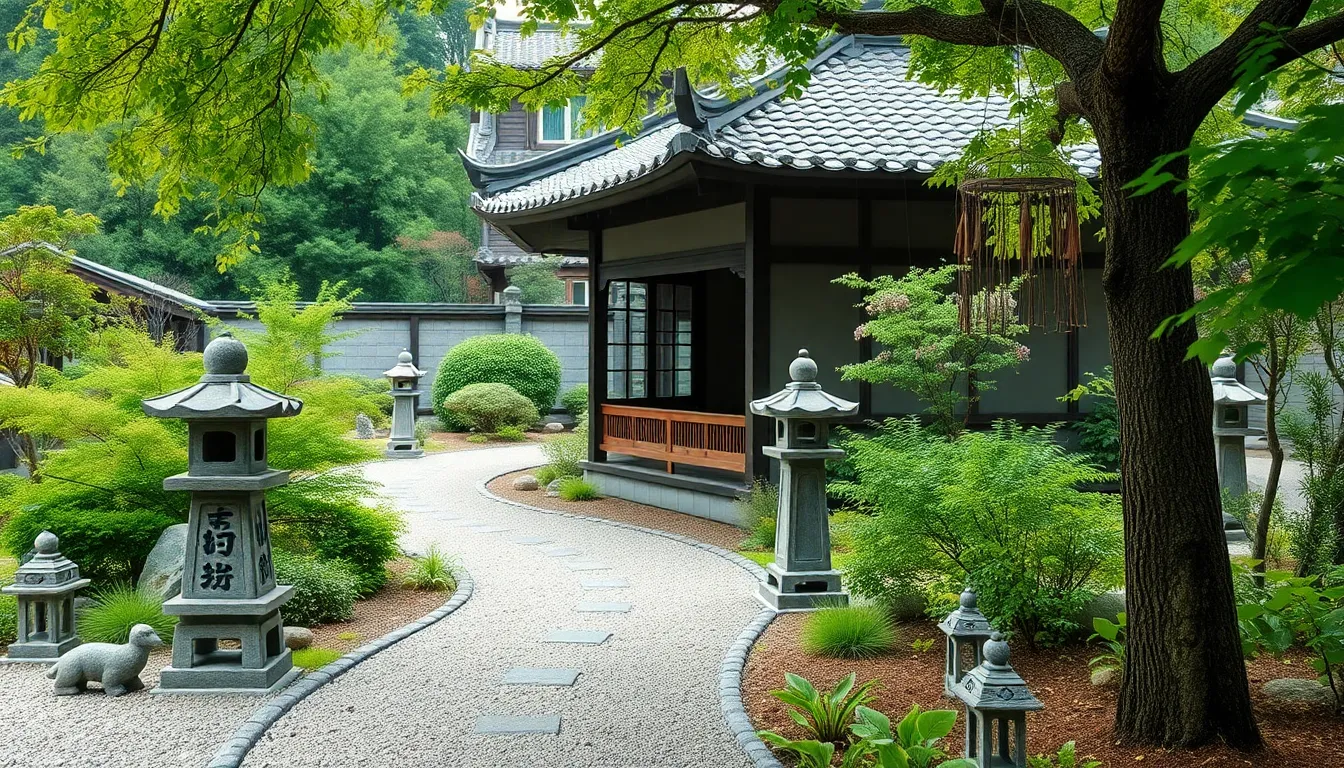
Accessories serve as focal points that reflect traditional Zen aesthetics while adding deeper meaning to your garden space. These carefully chosen elements symbolize harmony, balance, and the passage of time.
Place Traditional Stone Lanterns
Stone lanterns provide both illumination and symbolic presence in your zen garden design. We recommend positioning these classic elements along pathways or near water features to guide visitors while creating mystery and contemplation. Their placement marks seasonal transitions and highlights special meditation spots throughout your garden.
Traditional lanterns work best when they complement your garden’s natural flow rather than dominating the industry. Consider placing them at pathway intersections or beside seating areas where their gentle glow enhances evening meditation sessions. The weathered texture of stone lanterns adds authentic character that deepens over time.
Include Meaningful Sculpture Pieces
Sculptures introduce layers of philosophical meaning that transform your garden into a reflective sanctuary. Buddha figures and animal statues represent exact teachings or stories that align with your garden’s contemplative purpose. We suggest choosing pieces that resonate with your personal meditation practice or spiritual journey.
Placement near meditation areas or among natural rocks and plants reinforces the garden’s reflective environment. Smaller sculptures work well nestled between plantings, while larger pieces can anchor exact zones within your zen space. The key lies in selecting sculptures that enhance rather than compete with your garden’s natural elements.
Add Wind Chimes for Gentle Sounds
Wind chimes create ambient sounds that support meditation by masking distracting neighborhood noise. While not traditional to authentic Zen gardens, these popular Western adaptations contribute to a multi-sensory experience that many find deeply calming. We recommend choosing chimes made from metal, bamboo, or ceramic to blend harmoniously with natural garden elements.
Position wind chimes where gentle breezes will activate them without creating overwhelming sound. The soft tones should complement rather than dominate your garden’s peaceful atmosphere, providing just enough auditory texture to enhance your contemplative practice.
Design Proper Lighting for Evening Use
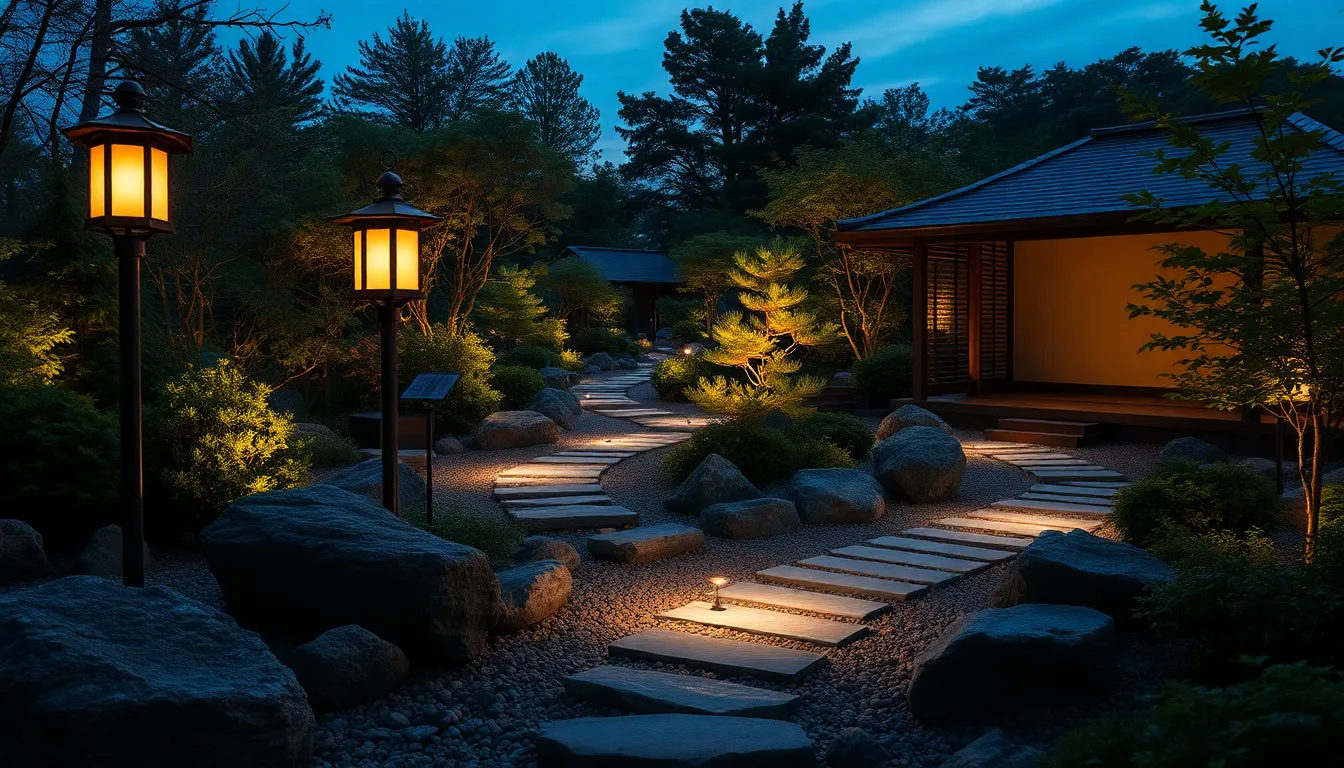
Evening lighting transforms our zen garden into a sanctuary that welcomes meditation and reflection after sunset. Thoughtful illumination extends the peaceful atmosphere throughout the night hours.
Install Soft Solar-Powered Lights
Solar powered lights offer the perfect solution for creating gentle evening ambiance without increasing electricity costs. These eco friendly fixtures harness daytime sunlight to provide consistent illumination that won’t disrupt the garden’s natural harmony.
We recommend positioning solar lights along the perimeter of seating areas and near water features where their soft glow can reflect off surfaces. The warm LED bulbs produce a golden light that enhances the meditative quality of evening garden visits. Installing these fixtures requires no electrical work since they operate independently through built-in solar panels.
Choose solar lights with adjustable brightness settings to customize the illumination level for different meditation practices. Models with automatic dusk to dawn sensors activate precisely when needed and conserve energy throughout the night.
Use Lanterns for Ambient Illumination
Lanterns provide traditional aesthetic appeal while delivering functional ambient lighting for evening zen garden experiences. Stone lanterns complement the natural materials we’ve already incorporated, such as river rocks and wooden elements, creating visual continuity throughout the space.
Metal lanterns offer durability against weather conditions and can house LED candles for safe, flickering light that mimics traditional flames. We suggest placing these lanterns at strategic points like pathway intersections and near meditation benches to create pools of warm light.
Traditional Japanese lanterns add authentic cultural elements that enhance the spiritual atmosphere of our zen garden design. Battery operated versions eliminate safety concerns while maintaining the classic appearance that supports contemplative practices.
Create Subtle Pathway Lighting
Pathway lighting ensures safe navigation while preserving the tranquil atmosphere we’ve cultivated through careful plant selection and stone placement. Low voltage LED strips installed along stepping stone trails provide gentle guidance without overwhelming the senses.
We recommend installing lights that cast downward illumination to minimize light pollution and maintain focus on the meditative journey. Small fixtures positioned every 3 to 4 feet along gravel walkways create consistent visibility while respecting the garden’s peaceful character.
Ground level spotlights can highlight exact design elements like bonsai trees or sculptural rocks, adding visual interest to evening walks. These accent lights should complement rather than compete with the subtle ambient lighting from lanterns and solar fixtures we’ve positioned throughout the space.
Plan for Seasonal Interest and Maintenance
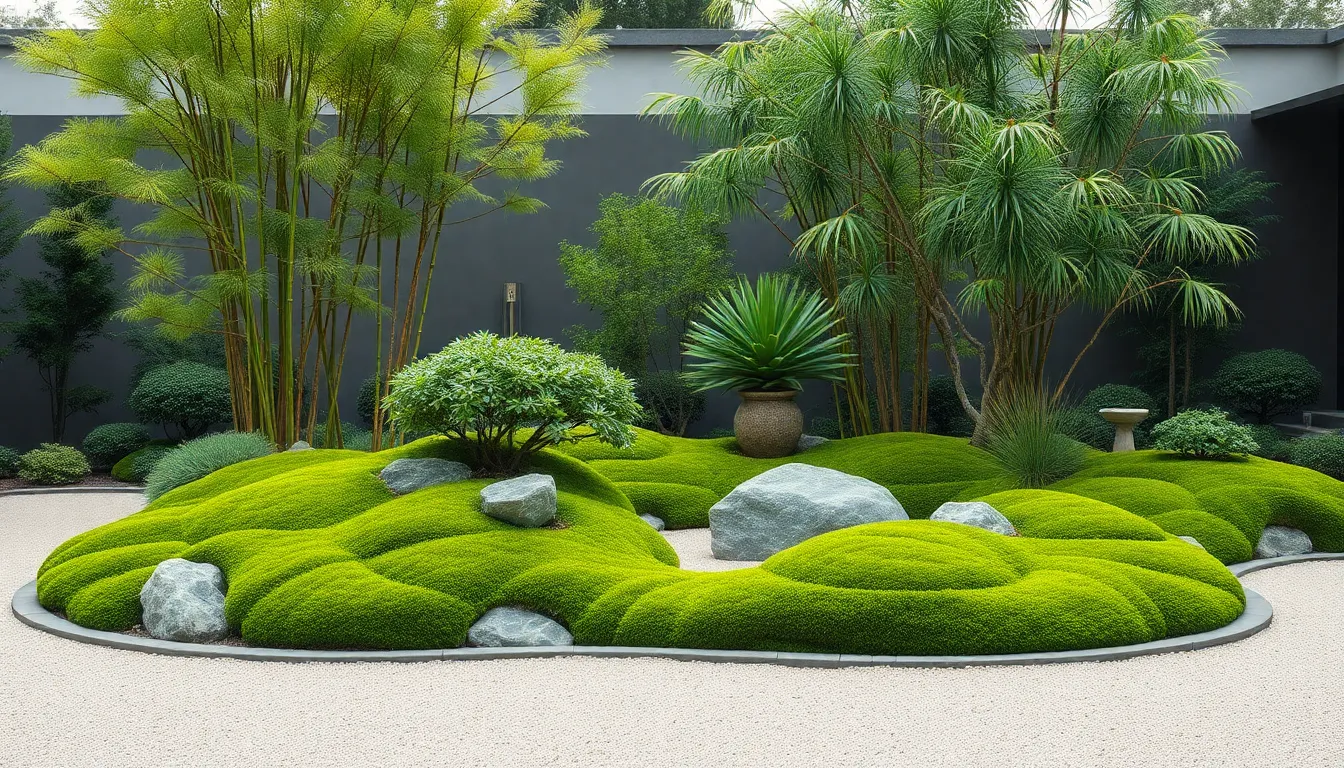
Creating a zen garden that remains beautiful throughout the year requires thoughtful planning and consistent care. We’ll explore essential strategies to maintain your peaceful sanctuary across all seasons while preserving its meditative qualities.
Select Plants for Year-Round Appeal
Moss varieties provide the foundation for consistent greenery in your zen garden throughout every season. These low maintenance plants create a lush carpet that thrives in shaded areas and requires minimal watering once established.
Bamboo species offer vertical interest with their elegant stems and gentle rustling sounds that enhance meditation. We recommend selecting clumping varieties rather than running types to prevent aggressive spreading and maintain your garden’s controlled aesthetic.
Dwarf conifers maintain their sculptural form year round with minimal pruning requirements. These evergreen specimens, such as dwarf pine or juniper varieties, provide structural elements that anchor your garden’s design through seasonal changes.
Ornamental grasses create movement when gentle breezes flow through your meditation space. Species like fountain grass or Japanese forest grass add textural contrast while requiring only annual cutting back in late winter.
Establish Simple Upkeep Routines
Regular raking transforms maintenance into meditation as you create fresh patterns in your gravel or sand areas. This practice typically takes 10 to 15 minutes weekly and helps clear both your garden and your mind.
Pruning schedules keep plants healthy while preserving their intended shapes within your zen design. We suggest monthly trimming for fast growing plants like bamboo and seasonal shaping for slower growing specimens.
Debris removal maintains clean lines that are essential to zen garden aesthetics. Sweeping leaves and fallen branches weekly prevents accumulation that can disrupt your garden’s peaceful appearance.
Weeding prevents unwanted growth from compromising your carefully planned plant arrangements. Checking for weeds bi weekly during growing season helps maintain the intentional simplicity of your space.
Prepare for Weather-Related Care
Drainage systems protect your garden from water damage during heavy rains and snow melt. Installing French drains or gravel channels prevents pooling that can damage plants and create muddy areas in your meditation space.
Protective covers shield delicate elements during extreme weather conditions like hail or heavy snow. We recommend breathable fabric covers for plants and temporary shelters for raked sand areas during harsh storms.
Wind protection secures loose decorative elements such as lightweight stones or small sculptures that might shift during storms. Anchoring systems or temporary removal during high wind warnings preserve your garden’s carefully arranged features.
Heat management reduces stress on both plants and hardscape materials during summer months. Providing afternoon shade for sensitive plants and using light colored gravel helps prevent overheating in your meditation areas.
Conclusion
Creating your own zen garden transforms any outdoor space into a personal sanctuary where mindfulness and tranquility flourish. We’ve explored how simple elements like raked sand patterns stone arrangements and carefully chosen plants can work together to build a meditative retreat that supports your well-being throughout the seasons.
The beauty of zen garden design lies in its adaptability—whether you’re working with a small balcony or expansive yard these principles can be scaled to fit your unique space and needs. With thoughtful planning and regular maintenance your zen garden will become a lasting source of peace and reflection.
Remember that the most meaningful zen gardens evolve gradually over time. Start with the elements that resonate most with you and allow your garden to grow naturally as you discover what brings you the greatest sense of calm and connection to nature.
Frequently Asked Questions
What is a zen garden and what are its main benefits?
A zen garden is a peaceful outdoor space inspired by ancient Japanese design principles that promotes meditation and stress relief. The main benefits include creating a tranquil sanctuary for relaxation, reducing stress through mindful activities like raking sand patterns, and providing a beautiful low-maintenance landscape that enhances your well-being and connection with nature.
Do I need a large yard to create a zen garden?
No, you don’t need a large yard to create a zen garden. These peaceful spaces can be designed for various settings, from small balconies to larger yards. Even compact areas can accommodate miniature zen gardens with essential elements like sand, stones, and small plants, making this meditative practice accessible regardless of your space limitations.
What type of sand should I use for a traditional raked zen garden?
Use fine, clean sand specifically designed for zen gardens rather than coarse playground sand or beach sand. The ideal sand should be light-colored, fine-grained, and easy to rake into smooth patterns. This type of sand creates better visual appeal and allows for clean, precise raking that’s essential for the meditative practice.
What plants work best in a zen garden?
Low-maintenance plants that provide year-round interest work best, including moss varieties, sedum, ferns, bamboo, ornamental grasses, and bonsai trees. Choose plants that create gentle transitions between different heights and textures while requiring minimal care. Evergreen options ensure your garden maintains its beauty throughout all seasons.
How do I create pathways in my zen garden?
Create intentional pathways using stepping stones, curved gravel walkways, or wooden boardwalk sections. Space stepping stones 18-24 inches apart for comfortable walking pace. Design curved paths to encourage slow, mindful movement. Ensure all pathway materials harmonize with your garden’s aesthetic while promoting contemplative walking and meditation.
What water features can I add to enhance tranquility?
Consider adding a simple stone fountain, shallow reflecting pool, or bamboo water spout. These features should use natural materials and produce gentle, soothing sounds that support meditation. Position water features strategically to complement existing garden elements while creating focal points that enhance the overall peaceful atmosphere.
How do I maintain my zen garden throughout the seasons?
Regular maintenance includes raking sand patterns, pruning plants, removing debris, and weeding. Install proper drainage systems and protective covers for weather protection. Adjust seasonal plantings and decorative elements to maintain year-round interest. Simple weekly upkeep routines will preserve your garden’s meditative qualities and aesthetic appeal.
What lighting options work best for evening meditation?
Use soft solar-powered lights, traditional lanterns, and low-voltage LED pathway lighting to create gentle evening ambiance. Position lights along pathways and near water features for safe navigation while maintaining tranquility. Ground-level spotlights can highlight key design elements without overwhelming the peaceful atmosphere essential for evening meditation.

